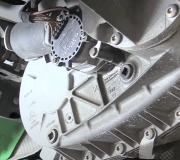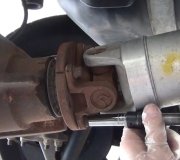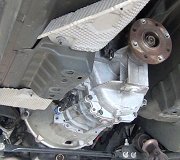Hi kvzrock. Welcome to the forum. The items to be looking at are the spring and the strut or shock absorber. Think of wearing two different socks or shoes. Neither one feels "wrong", they just feel different. It is customary to replace just one spring or strut that is damaged in a crash, but even though the parts are designed for your car, there can be differences between the new one and the old one on the other side. When doing routine maintenance, struts, shocks, springs, and tires are normally replaced in pairs to prevent any unbalanced conditions.
41,000 miles isn't a lot, but imagine if when your car was new, one spring was replaced with a three-year-old spring. It would certainly not ride the same. That could be what you have now is one new spring and one weaker three-year-old spring. Another possibility is in an attempt to avoid this mismatch, the mechanic may have installed a used spring thinking it would be closer in characteristics to the old one. That used spring could have seen many more miles or be years older and weaker.
The place to start is by measuring from the ground to some point on the body on both front corners of the car to see if it is sitting level. If, for example, the top of the side marker light is the same height on both sides, you're off to a good start. If you find a difference of, oh, say a half-inch or more, don't panic yet. It's just a good place to investigate further. Some cars actually do have differences side-to-side due to an uneven distribution of engine weight but that difference should not be excessive. The next thing to observe is how both corners of the car react when traveling over bumps that go straight across the road. By that I mean bumps that both tires hit at the same time. Railroad tracks are a perfect example. Watch the two corners of the hood to see if they bounce up and down at the same rate. Mismatched struts or shock absorbers are the main cause of unequal reaction but one spring that's stronger or stiffer than the other one will do this too.
If no problem is found with the suspension system, the alignment is the next place to look. If you were provided with a printout of the alignment that would have been needed, can you share the final numbers? In particular, left and right camber and caster will affect the handling. Without going into all the theory on alignment angles, they both affect which way the car will pull to one side when you let go of the steering wheel but they each have other characteristics. The actual values are not so critical. What is important is they are the same on both sides. If camber is not equal, it will cause a pull one way. Caster can be adjusted unequally to cause a counteracting pull the other way. That is fine on a flat smooth road, but as the front of the car goes up and down over bumpy roads, or you try to turn, the other characteristics come into play.
Camber changes very little as the suspension travels up and down but it is one angle that makes up a different measurement, steering axis inclination. There is no "correct" value for SAI; it just must be nearly equal on both sides. When something is shifted sideways, commonly the front crossmember the lower suspension parts are attached to, SAI and camber will change, but only camber can be easily readjusted. That would be like walking on a tilted sidewalk with one shoe that has a taller heel to make up for the height difference. Sure, you might be standing straight up and down, but it still won't feel right. Unequal SAI will make the car feel like it's moving sideways when the front end goes up and down. To correct that, SAI must be corrected to make it nearly equal on both sides, then camber must be readjusted.
Caster also has an effect on which way the car wants to go when you let go of the steering wheel, but that is mostly on rear-wheel-drive cars. It seems to have very little effect on front-wheel-drive cars and minivans. Still, there is one characteristic that caster causes that contributes to your symptoms. The wheel that is turned outward tends to lift that corner of the car. The weight that's trying to push that corner back down is what causes the steering wheel to return to center after cornering without you having to pull it back. The higher the caster, to a point, the more stability the car has and the easier it is to keep it going straight over bumpy roads. The drawback is higher caster makes it harder to turn the steering wheel. Power steering was developed, in part, to overcome that hard steering. Lower caster is what allowed us to have heavy cars and trucks in the 1940s and 50s that didn't have nor need power steering.
While unequal caster tends to not cause a pull on front-wheel-drive cars, and any pulls that do occur can be offset by changes to camber, the fact still remains that the two corners of the car will be raised by different amounts during turns. THAT can cause the feeling of turning harder in one direction than the other. It's important to note though that this amount of turning difference will not be noticed by a lot of drivers.
If you have a turning difference that is really significant, the steering mechanism could be not centered or there could be a valve problem inside it, possibly from the force of the crash. To tell if the steering gear is centered, turn the steering wheel full left and full right and see if it ends up in the same position. (See if it turns the same number of turns each way). If you find it turns a quarter turn more one way than the other, something is not centered, and during the final step of the alignment, the steering linkages were adjusted to accommodate that to make the steering wheel straight.
There's some things to get you started. If you received an alignment printout, holler back with the camber, caster, and SAI readings.
Caradiodoc
Wednesday, July 21st, 2010 AT 1:46 PM



